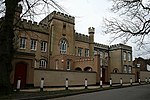Stoneleigh railway station
DfT Category C2 stationsFormer Southern Railway (UK) stationsLondon stations without latest usage statistics 1415London stations without latest usage statistics 1516London stations without latest usage statistics 1617 ... and 8 more
Rail transport stations in London fare zone 5Railway stations in Great Britain opened in 1932Railway stations in SurreyRailway stations served by South Western RailwaySouth East England railway station stubsSurrey building and structure stubsTransport in Epsom and EwellUse British English from August 2012

Stoneleigh railway station is in the Epsom and Ewell district of Surrey, England. The station is served by South Western Railway and is currently in Travelcard Zone 5 (because of its proximity to the Greater London boundary); it is the only National Rail station in zone 5 not to be located in a London borough. It is located in the residential area of Stoneleigh, Surrey at grid reference TQ221642, 11 miles 74 chains (19.2 km) down the line from London Waterloo.
Excerpt from the Wikipedia article Stoneleigh railway station (License: CC BY-SA 3.0, Authors, Images).Stoneleigh railway station
The Broadway Stoneleigh, Epsom and Ewell Stoneleigh
Geographical coordinates (GPS) Address Nearby Places Show on map
Geographical coordinates (GPS)
| Latitude | Longitude |
|---|---|
| N 51.363 ° | E -0.2485 ° |
Address
The Broadway Stoneleigh
KT17 2JA Epsom and Ewell, Stoneleigh
England, United Kingdom
Open on Google Maps







